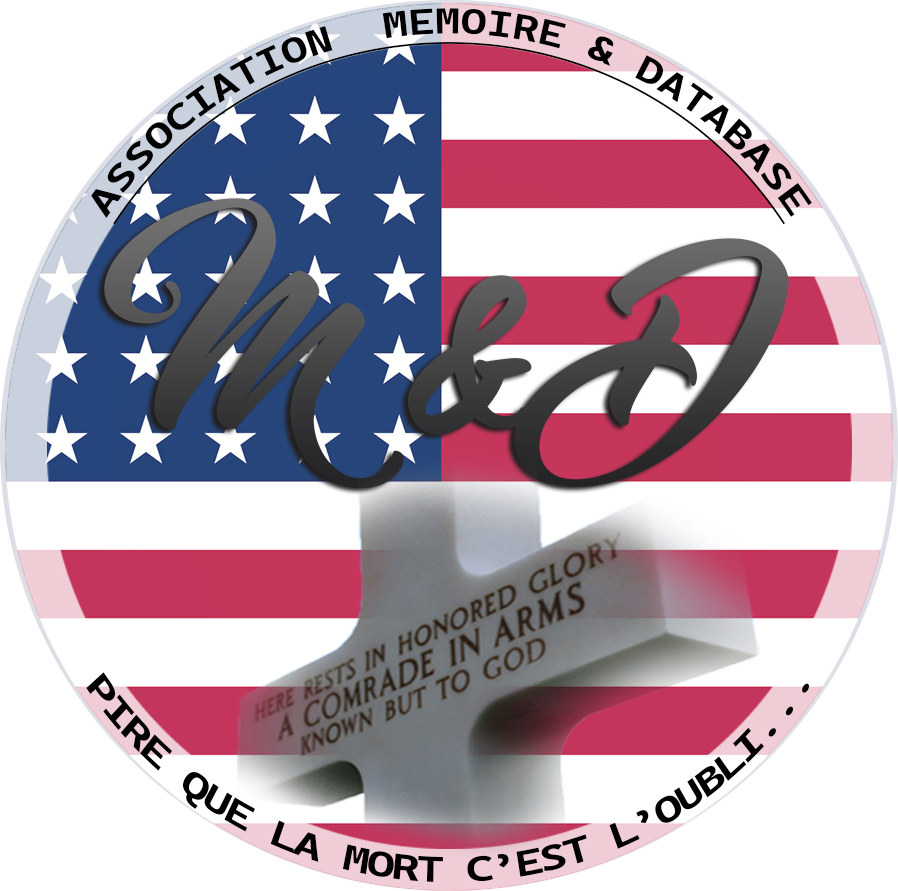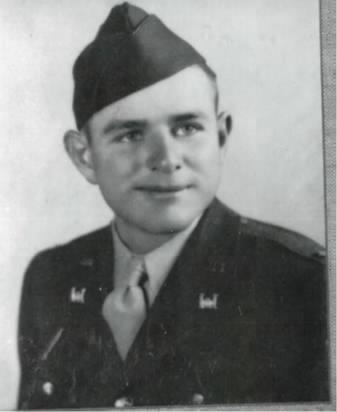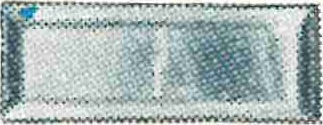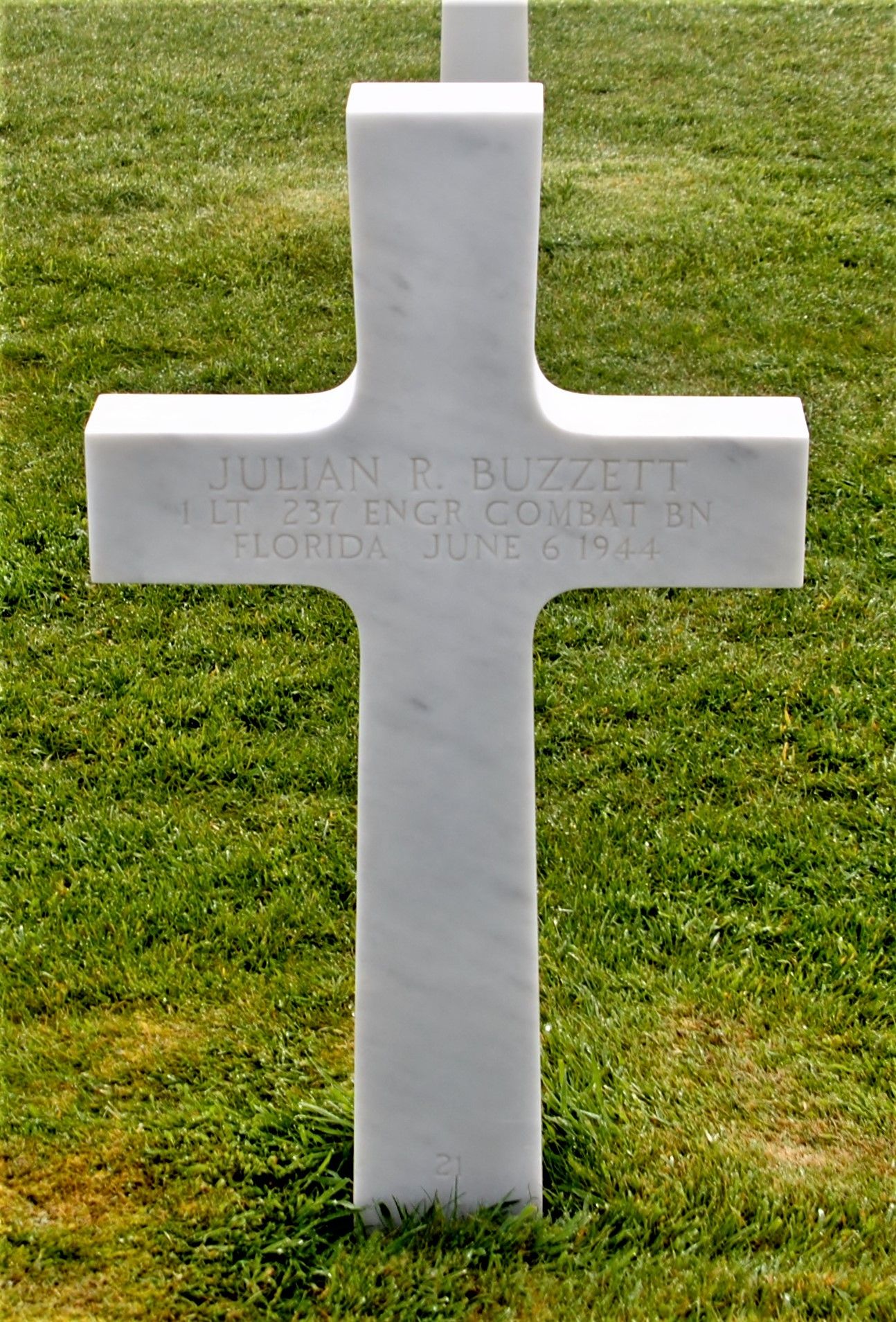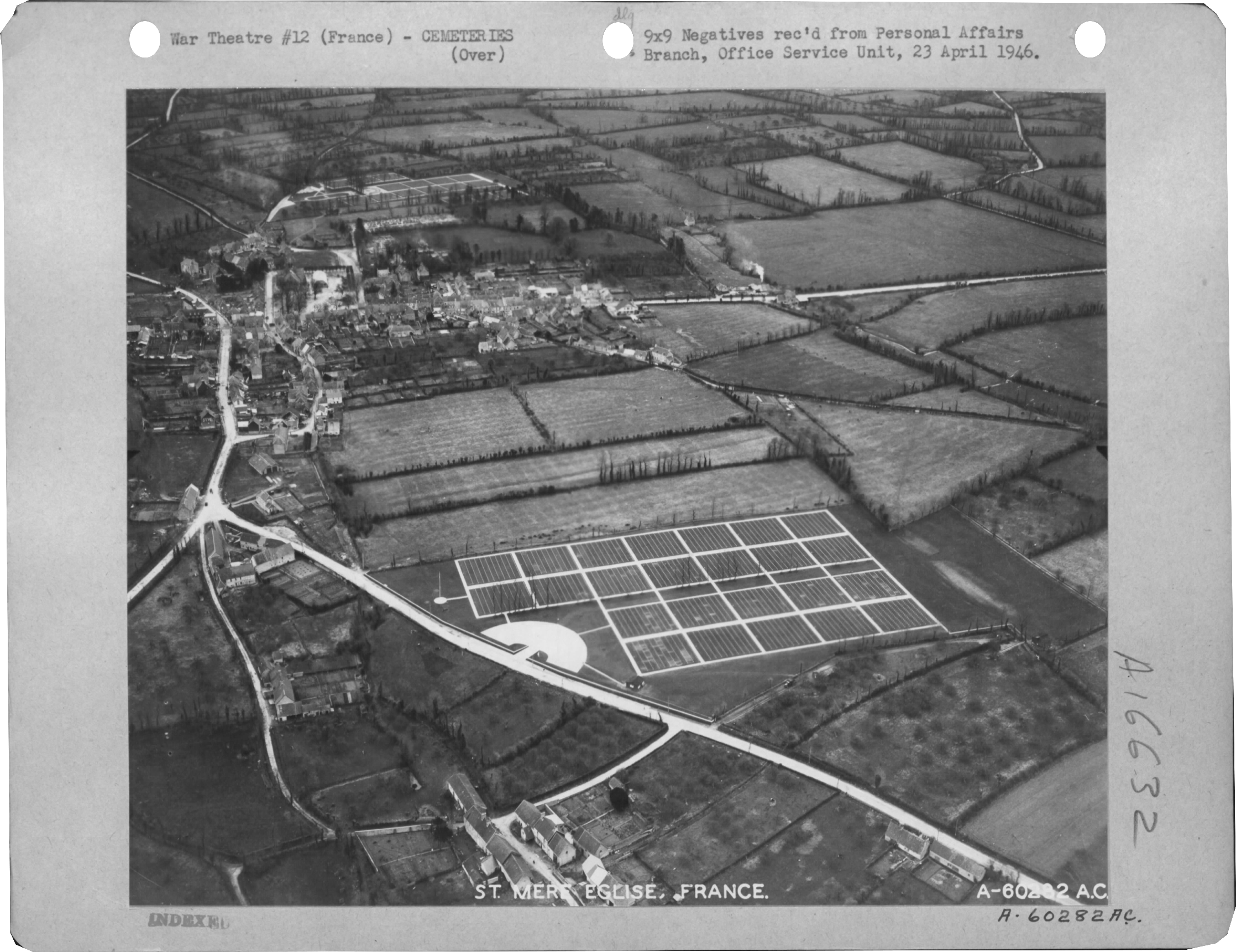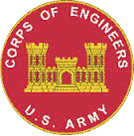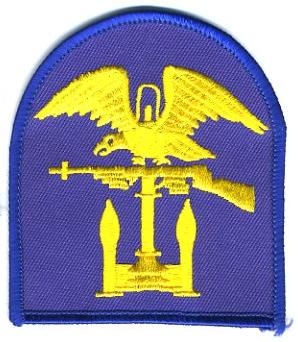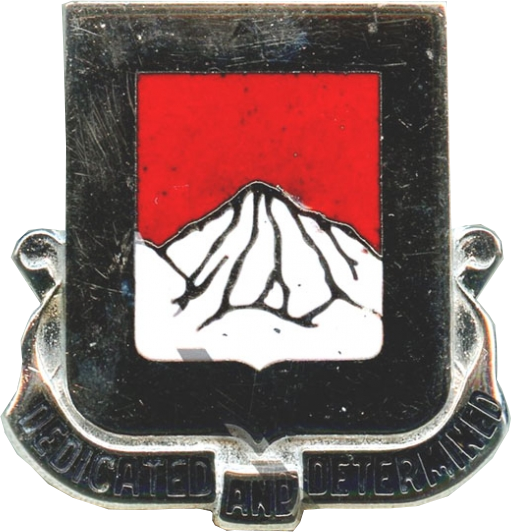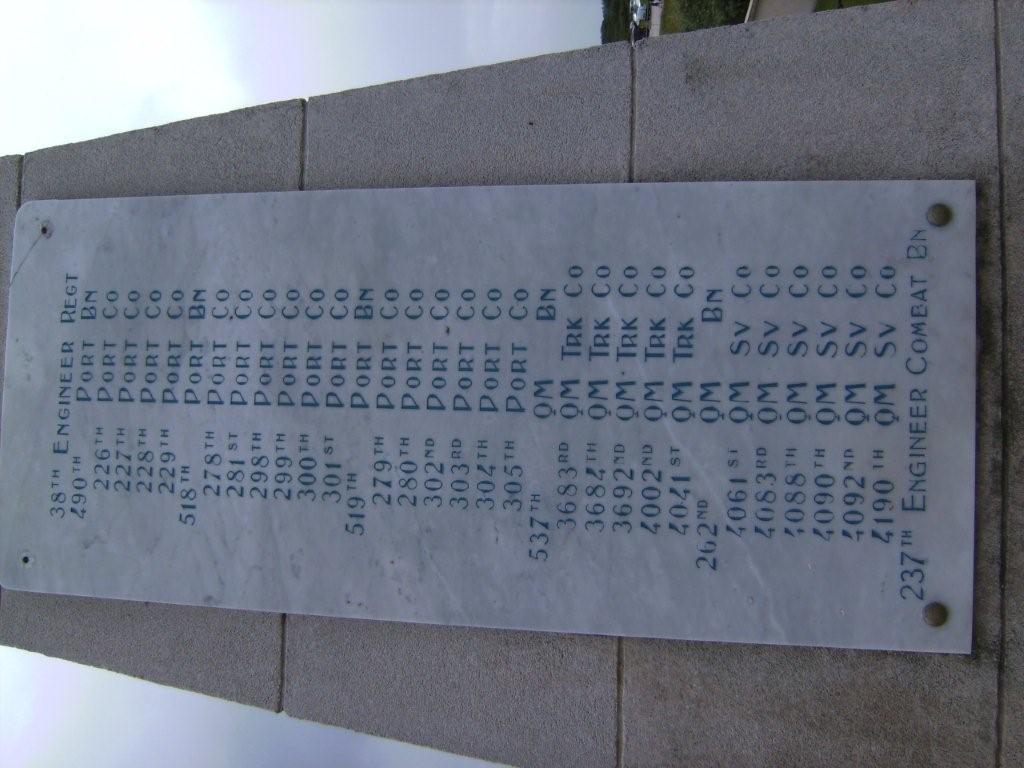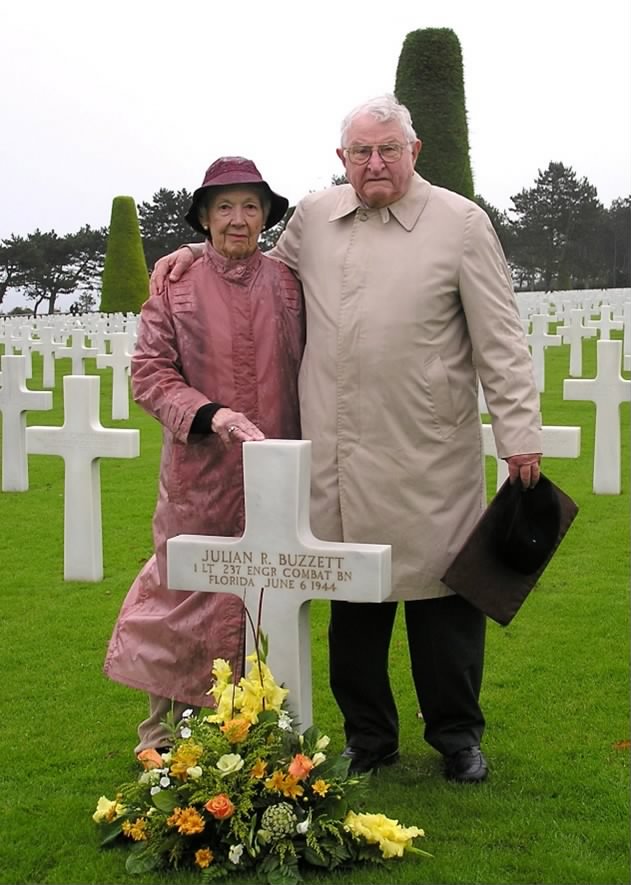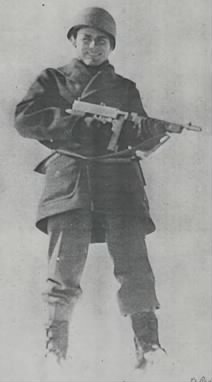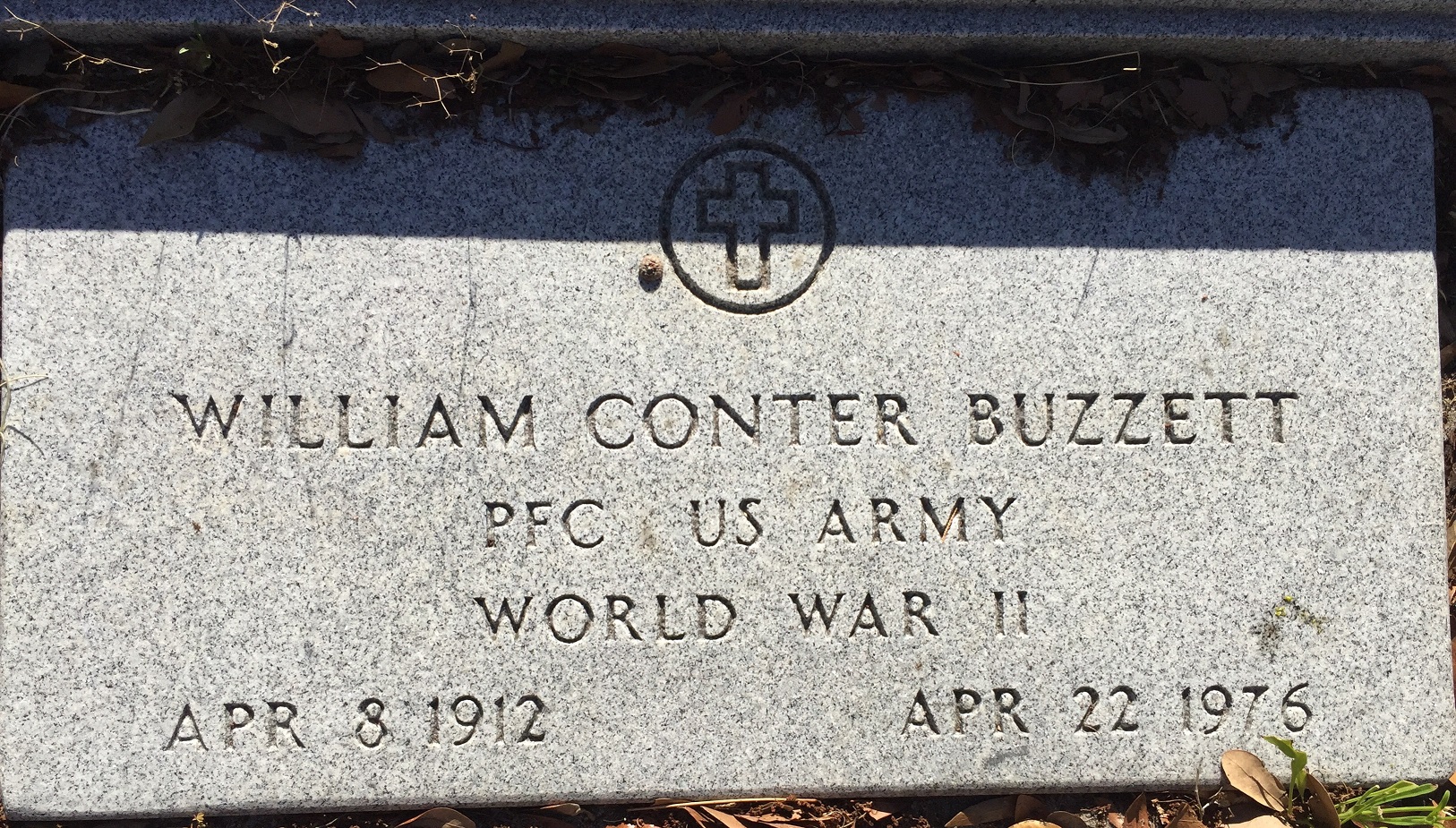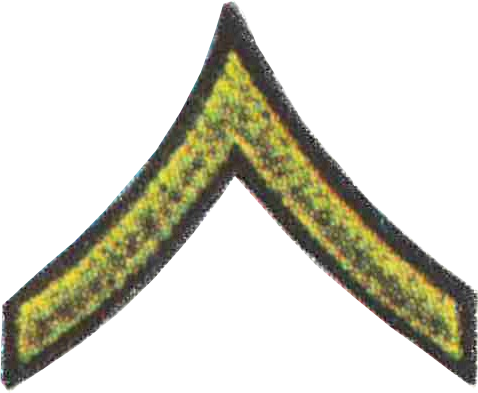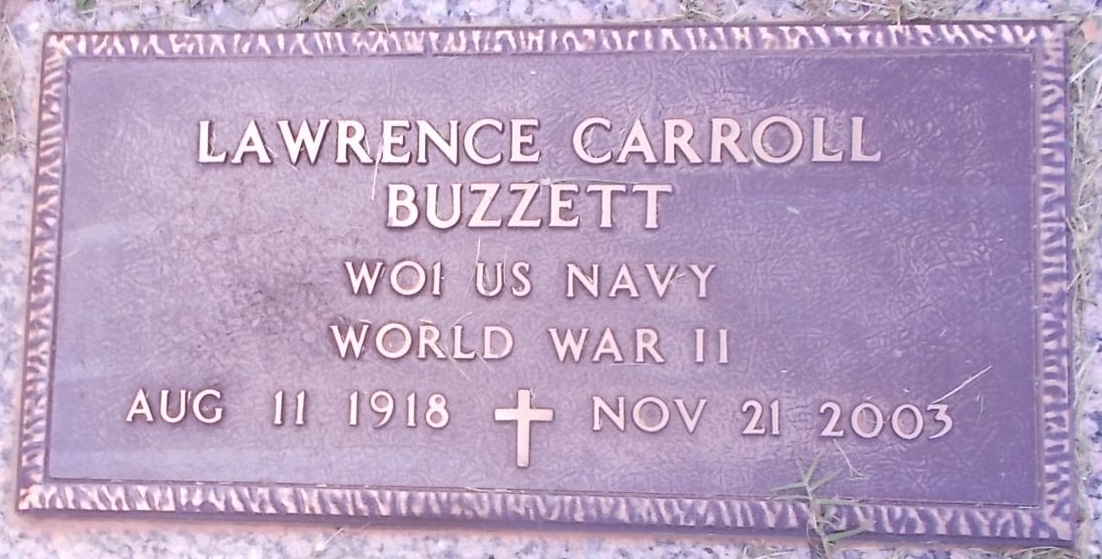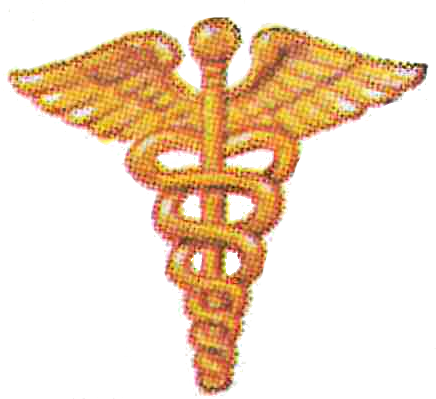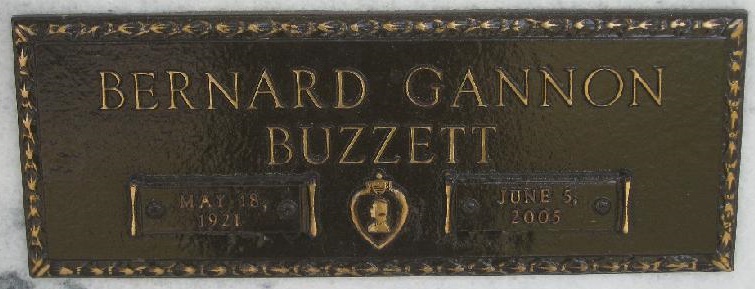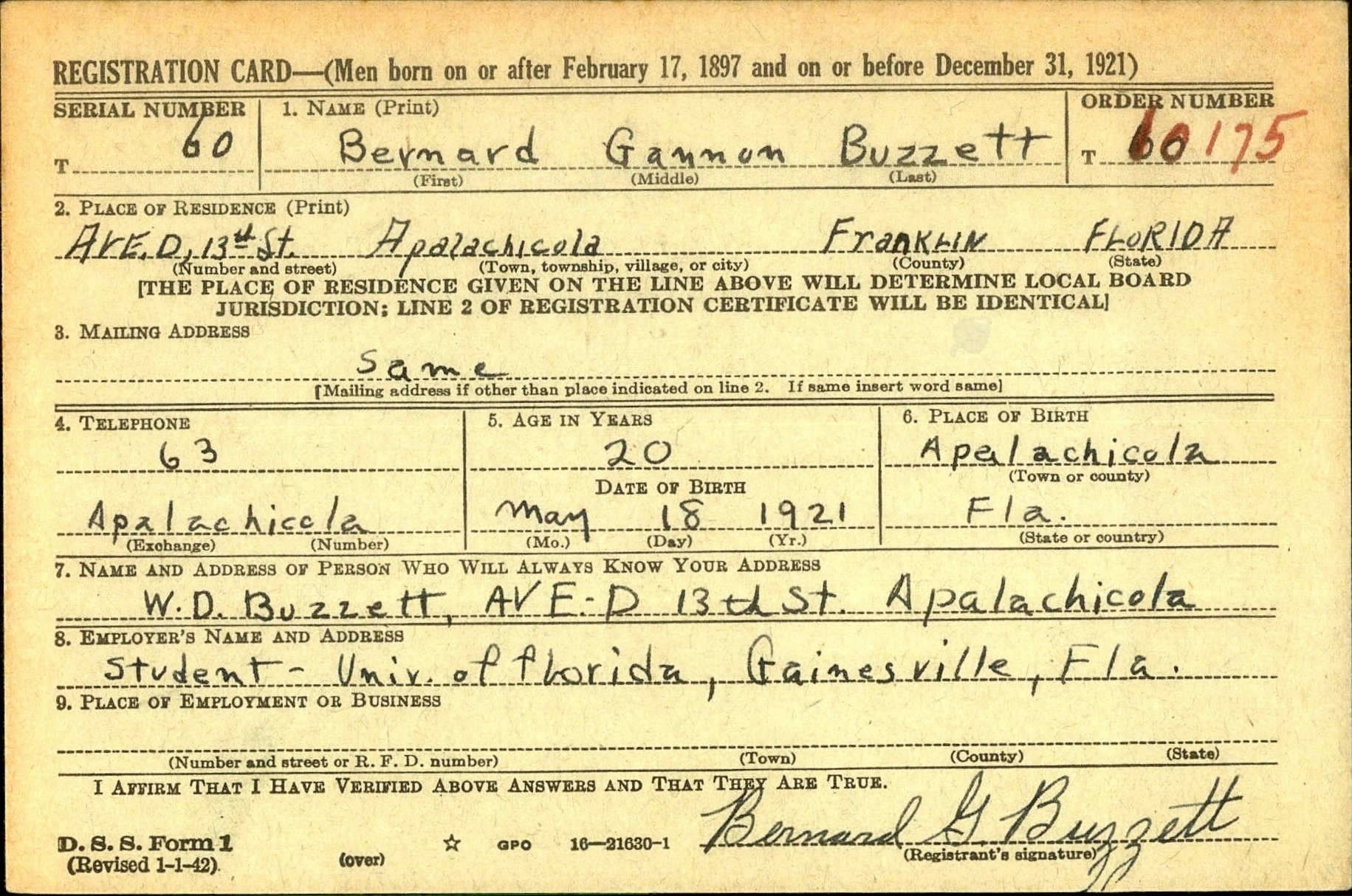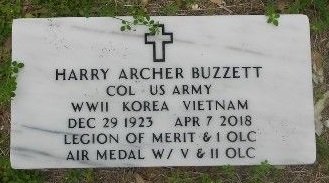|
Julian Rexall BUZZETT
| |||||||
|---|---|---|---|---|---|---|---|
|
Source : Frogman
| |||||||
| NUMBER OF SERVICE | O-1102177 (20428224) | ||||||
| AGE | 32 yo | ||||||
| DATE OF BIRTH | 25 January 1912 Apalachicola, Franklin County, FLORIDA | ||||||
| ENLISTMENT STATE | FLORIDA | ||||||
| FAMILY |
Parents : William Domingo & Regina Gannon BUZZETT Siblings : John Joe, William C., Julian Rex, Regina, Lawrence Carroll, Bernard Gannon & Harry Archer Half siblings : Margaret Etta Cumberworth Eberly | ||||||
| RANK |
| ||||||
| FONCTION | Fonction | ||||||
| JOB BEFORE ENLISTEMENT | Clerks, general |  | |||||
| DATE of ENLISTEMENT | 25 November 1940 Apalachicola Aaf FLORIDA | ||||||
| COMPANY | Company C | ||||||
| BATTALION | 237th Engineer Combat Battalion | ||||||
| GROUP | 1106th Engineer Combat Group | ||||||
| DATE OF DEATH | 6 June 1944 |
Source : Frogman
| |||||
| STATUS | DOW | ||||||
| CEMETERY TEMPORARY |
CEMETERY TEMPORARY of Sainte Mère Eglise #2 N°3586
| ||||||
| CEMETERY | NORMANDY AMERICAN CEMETERY of Colleville | ||||||
| GRAVE |
| ||||||
| DECORATION |
| ||||||
| |||||||
| STORY | |||||||
|
This is the monument at Utah Beach, Normandy, France - where the 237th Engineer Bn is mentioned.
Source : Frogman
|
D-Day Fallen -- Lt. Julian Rexall Buzzett; Farewell Letter to His Family The death on D-Day of First Lieutenant Julian Rexall (Rex) Buzzett, 30, was much like many of the 2,500 men who died that day. He jumped from a landing craft, waded ashore, fought his way about a mile inland, and was killed by German artillery. But there’s more to his story – much more.
As he sailed toward France aboard a transport ship, Lt. Buzzett took out his copy of a letter from General Dwight D. Eisenhower that had been distributed to all troops in the invading force. On the back of Ike’s letter, Rex wrote a message to be given to his family should he be killed. That message was not discovered until 13 years later by his brother, Harry, a career Army officer who served in World War II, Korea, and Vietnam. The full story of Lieutenant Buzzett, his letter, and his family’s sacrifice during the war was told on the 75th anniversary of D-Day in a guest article written for a newspaper by his nephew, Harry’s son, Joe Buzzett. The complete text is reproduced at the end of this story.
Rex was born in Apalachicola, Florida on Jan. 25, 1914, the son of Dr. William D. Buzzett and Regina Gannon Buzzett. Rex was the third of their seven children, six boys and a girl. Four of his brothers served in World War II.
His father was a pharmacist and owner of Rexall drug store in Apalachicola. Dr. Buzzett was proud of his association with the Rexall chain, thus his son’s middle name. Rex’s mother died at age 38 in 1924, right before Rex’s 10th birthday and 30 days after giving birth to Harry. His father remarried a few years later to Lavina Cumberworth Johnson, a widow. Rex was a combat engineer assigned to 1106th Engineer Combat Group, 237th Combat Engineers, Company C, and had previously served in North Africa. His unit’s assignment on D-Day was to breach obstacles on Utah Beach to clear the way for troops from the 4th Infantry Division.
His unit left England around 1 a.m. on June 6. He attended Mass on the transport ship and wrote the letter to his family. After crossing the choppy English Channel, they boarded landing craft and went ashore at Utah Beach around 6:30 a.m. By about 7:30 he and his platoon had made it a mile inland and were attacking a German pillbox when he was struck by shrapnel, probably from a German 88-millimeter artillery shell. The family was told in June that Rex had been wounded, and news of his death reached his family on July 4, the day before his sister was to be married. The family withheld the news from her until after her honeymoon.
Rex was originally buried at Sainte-Mère-Église #2 cemetery, and his remains were later moved to the Normandy American Cemetery. Many family members have visited his grave and walked Utah Beach. He is also honored by a memorial marker at the Buzzett family plot in the Magnolia Cemetery in Apalachicola.
| ||||||
|
Following is Joe Buzzett’s tribute to his uncle, written for the 75th anniversary of D-Day in 2019 and published in Florida’s _Port St. Joe Star _newspaper :
BEGIN QUOTE FROM NEWSPAPER
THE FAREWELL LETTER By Joe Buzzett; Special to the Times
June 6, 2019
It was always important to my father to note the exact time of death of a loved one, he would always call and say “your uncle, aunt, or relative died at 1:57 this morning.” It marked the exact time of the end of an amazing life that warranted being noted to the hour and minute. Life is so precious that it is important to know when and where it started and when and where it ended.
With the 75th anniversary of the D-Day landings on Utah Beach on June 6, I thought it would be important to note circumstances and death of my father’s brother and my uncle Julian Rexall (Rex) Buzzett. Fortunately, the D-Day landings are one of the most reported on and written about events in the history of mankind. I was lucky enough to find several reference books and more importantly family archives that help determine the near exact location and time of his death on Utah Beach. Most importantly, a farewell letter that was discovered some 13 years after Rex’s death.
Seventy-five years ago, my uncle, 1st Lt. Julian Rexall Buzzett, wrote a letter, a letter he hoped no one would ever read. Thirteen years later my father, Harry Archer Buzzett, discovered the letter, folded into 12ths, adhered to the inner pocket of Rex’s wallet. The wallet, a rusted watch with the time stopped at 11:17, and an engineer’s notebook were sent to Dr. William D. Buzzett, Rex and Harry’s father, soon after the war. Dr. Buzzett insisted that Harry, his youngest son and an Army captain, take Rex’s possessions. Harry resisted, but after many visits home to Apalachicola, he finally consented to his father’s wishes some 13 years later and took his brother’s personal items.
It was upon returning back to his post at Ft. McPherson, Georgia , where the Army had stationed him to get an advanced degree, that Harry discovered the letter while in his quarters. He had left the wallet, watch, and engineer’s notebook on a table. While he was studying at his desk one day, some light that came glaring through the window and onto the table caught his attention. He walked over to the table and started opening the wallet, looking through it. | |||||||
Tucked away in one of the inner pockets of the dried-out wallet, damaged from being soaked in the cold salt water of the English Channel, was the folded letter. Shocked, Harry unfolded the letter and read it. Later that week he met with his older brother, Lawrence Carroll Buzzett, who also lived in Atlanta, and showed him the letter.
He was in a conundrum. He knew how much the death of Rex had hurt his father and did not want to reopen old wounds by sharing this letter with him. His father had already come to terms with Rex’s death years earlier. In a short note of thanks published in the Apalachicola Times some weeks after the paper had announced Rex’s death, Wil thanked the community for their condolences and wrote that he found comfort in the last letter he received from Rex in May 1944, stating: “Still in England, Dear Daddy and All, - Don’t worry about me for if, and whenever anything happens, I will be ready spiritually and otherwise.”
Harry asked Carroll for advice. The answer was simple. “You must send the letter to Daddy, it is addressed to him.” So Harry sent the letter home to his father but before doing so, he made a copy of the letter on one of the copying machines on campus at Georgia Tech, in case it got lost in the mail.
The letter was not lost in the mail; however, it was burned to ashes by Margaret (Mag) W. Buzzett, Wil’s sister, who lived at the family house, soon after they had both read it. Rex was Aunt Mag’s favorite nephew and she took his death very hard. She hated everything about the Army and even destroyed a portrait Harry had sent home for safekeeping while he was in the war.
My father passed away last year at the age of 94. He kept the copy of the letter in a notebook binder and gave it to me a few years ago. I’ve read it with him several times and we have been able to decipher most of the words which are legible, except for a few sentences that were partially masked by lines made by the copy machine over the creases in the paper.
It was written on the back side of a letter written by Gen. Dwight David Eisenhower and given to each of the Allied troops embarking from England to invade the Norman coast. He had several notes written on the letter of times (115 am, 245 am) and then in all caps “NO LIGHTS” which were likely the final orders he had jotted down before embarking on the transport ship, the Imperial, which left from Plymouth, England just after midnight. The letter, written in perfect cursive penmanship, had the first sentences neatly flowing across the page and the later sentences, each containing more words, starting to crowd each other as the lines progressed down the page, to allow him to share more of his final thoughts with his family before he finally ran out of room.
|
Cathy and Harry Buzzett visiting Rex Buzzett grave Normandy
By : jfschlat515 | ||||||
|
Rex Buzzett during training in England
By : jfschlat515 |
It read: Aboard Ship Night Before Invasion 6/5/44 Dear Daddy and All, I hope you never read this letter, but if you do I’ll be in another world with Momma, God willing. I’ve been to confession and Holy Communion aboard ship, and if God calls me I’m not afraid to do face death. I’ve tried to live a life according to the Catholic Church and to my upbringing (Illegible due to crease in paper) Mass on Sunday (Illegible). My only regret will be the sorrow that I will cause you all to (Illegible). Daddy I’m sorry for the way I behaved toward you and Miss Lavina, I’m glad you married her and thankful for the happiness she brought you, she made you a good wife. Miss Lavina my apologies for the way I acted toward you. Mag and Anna you have been like a mother to one and all of us and you gave us every thing and now and you both have a place in (Illegible) As for Sister and all my brothers , I guess I haven’t openly displayed much affection towards you but I’ve certainly felt it inside. I’ve (illegible due to crease in paper) Love to All, Rex (p.s.) Bill, take care of my dogs
(Handwritten notes on right side – “115/245/NO LIGHTS” and” & lights on both Imperial Cl”) | ||||||
|
The Invasion
Rex was a combat engineer assigned to 1106th Engineer Combat Group, 237th Combat Engineers, Company C. The 237th was originally sent to North Africa with plans to go to the Pacific theatre when D-Day planners (specifically Gen. Montgomery) expanded the plans for the D-Day invasion and recalled the 237th in early 1944 back to England to support the invasion. In a letter dated March 5, 1944 to his sister Regina, Rex recalls his time in North Africa and his appreciation for Regina taking care of things in Apalachicola for him while he was away. He pledges to relieve her of this duty next year when he returns.
The 237th was assigned as a support unit for the 4th Infantry Division, known as the “Ivy Division,” the main invasion force for Utah Beach. This force was dubbed Task Force U. Task Force U departed on an embankment pier at Plymouth at approximately 1:15 a.m. on June 6 on the British transport SS Empire Gauntlet. The Empire along with the SS President Roosevelt each carried about 1,400 troops and 26 landing craft which carried the troops destined to land on Tare Green Beach, the southern/westernmost landing zone.
Rex went to Mass and wrote his farewell letter aboard ship. The transport ships reached their stations in the transport area 17,600 meters off of Utah Beach at about 2 a.m. and waited. At 4 a.m. the landing craft known as Landing Craft Vehicle Personnel (LCVP) or “Higgins Boats,” named after their designer Andrew Higgins, began to be lowered from the transport ships and set off on their long and rough journey through the English Channel to a place known as “Area Vermont,” where the craft kept station before being signaled to go forward to land. Each LCVP carried about 36 troops.
The 237th Combat Engineers, C Company, landed with the D Company, 8th Regimental Combat Team, 4th ID, during the 5th Wave at H-Hour + 30 minutes of the initial landing force. The 237th task was to clear the beach of obstacles for the main invasion force, and to breach large holes in the seawalls to allow larger armored vehicles through. In his pocket, Rex had an engineer’s notebook which carefully noted how to set an explosive charge to breach holes in various structures that may be encountered on the beach.
Rex’s platoon of 36 men were loaded into a LCVP that was on the southern flank of six LCVPs, four carrying Company D, eight RCT (regimental combat team) combat troops and one carrying another platoon on the 237th. Their destination with Tare Green Beach, the northernmost of the three designated Utah beach landing areas. Charles Gant, a young first lieutenant with Rex in the 237th, was the leader of the other platoon. Charles visited William Rex Buzzett (Rex’s nephew) in 1994, near the 50th anniversary of D-Day, and later wrote a letter to Rex saying “Your uncle’s platoon was on my left when we hit the beach. I did not see him that day but was told later that he was killed. That was a tough bit of news.”
The strong southward currents encountered on June 6 pushed the invasion force approximately 2,000 yards south of their planned locations which were marked by a windmill. Rex’s LCVP landed near a landmark known as La Grande Dune, some 1,500 yards south of the windmill, further marked by a road known as Exit 2. Four main roads, exits 1-4, were targeted by the Allies to be used to move the mechanized forces inland. There was a chapel at Le Madeleine, likely visible from the shore as well.
After disembarking from his landing ship, Rex likely encountered “Belgian Gates,” metal latticework, concrete posts, and thick wooden posts topped with mines. After moving about one mile inland, he led an assault on a German pillbox just beyond the seawall. At about 7:30 a.m., Rex was struck and killed by the fragments of a 88mm shell likely fired from the German 709th Infantry Division, 739th Grenadier Regiment, 3rd Company (known as WN-104) which manned a Wiederstandnester (resistance nest) built into the sand dunes above the seawall. These German Resistance Nests were strategically placed about a mile apart as part of the Atlantic front. The resistance nest faced out to sea with a central “Tobruk Pit” (concrete emplacement) and was fitted with one 88mm, two 75mm, one 50mm anti-tank weapon and a 80mm mortar.
Years later, in the Pentagon, a soldier stopped my father, seeing the name “Buzzett” on his uniform and asked, “Did you know Julian?”
“Yes, he was my brother,” my father replied.
“I was his company commander. I was with him on the beach. He was hit by an 88 fragment and died soon afterward.”
It was some comfort to my father to know exactly how his brother died and that he did not suffer for a long time. One of just 197 soldiers to give his life at Utah Beach, Rex died about one mile inland at about 7:30 a.m., less than an hour after he hit the beach. His watch stopped at 11:17 a.m. from not having been winded, later rusting at the edges from being soaked in the cold water of the English Channel.
The Buzzett Family
The family was notified in late June that Rex had been injured during the invasion but no further information available. The news of Rex’s death was delivered to the family on July 4 as they were preparing for the wedding of Regina Buzzett Misiavag, Rex’s only sister, on the next day. The family met and decided not to tell Regina of the news until after her wedding and honeymoon.
After his graduation from West Point on June 6, Harry was home on leave for the wedding. He later deployed to France, crossing the English Channel on Christmas Eve 1944. It was ironic that within several weeks Gen. Eisenhower had written a letter to both Harry (as a class member of the West Point class of 1944) and to Rex (as a member of the invading force). Gen. Eisenhower’s son, John, was also a member of the class of 44.
The Buzzett family consisted of six boys - John Joe, Carroll, Rex, Billy, Gannon, and Harry - and one girl, Regina. During World War II Carroll, Billy, Gannon and Harry would also serve. Carroll was a Navy combat medic who survived the horrors of Guadalcanal in the Pacific serving from 1941-45. Billy served at Ft. Dix, New Jersey. Gannon was an Army medic who fought in three campaigns including the Battle of the Bulge during the winter of 1944-45, suffering frostbite on his feet. Harry fought with the French against the Nazis in Lucerne, France as a forward observer until the end of the war and went on to fight in Korea and Vietnam during his 30-year Army career, retiring as a colonel in 1973.
John Joe and Regina were pharmacists that worked with their father at Buzzett’s Drug Store. Their mother, Regina, died 30 days after Harry’s birth in 1924 and Wil remarried a few years later.
Rex was born in Apalachicola on Jan. 25, 1914. During his youth he was known as an upstanding and courageous boy. Harry recalled that Rex once entered a burning convent school to retrieve the Blessed Sacrament from the chapel. He was named after the Rexall drug store brand, a favorite of his father’s, who was the owner and pharmacist of Buzzett’s Rexall Drug Store. Rex was very proud of his name and wanted to be a pharmacist one day. He wrote a 1937 article in the Rexall AdVantages magazine telling of how proud his family was to have a Rexall drug store. Four of his siblings, John Joe, Carrol, Regina and Gannon, became pharmacists all working at one time at Buzzett’s Drug store. His nephew, Rex Buzzett, also became a pharmacist taking over his father Gannon’s Buzzett’s Drug Store in nearby Port St. Joe.
Rex was originally buried at Sainte- Mère-Église #2 cemetery which Harry had a chance to visit in 1947 on his way home from the war. His body was later moved to the American Cemetery, Omaha Beach, Colleville-Sur-Mer, France. A memorial marker for Rex stands at the Buzzett family plot in the Apalachicola cemetery. Later in 1977, Harry was able to get permission from the superintendent of the cemetery to have permanently buried in front of the cross a rosary blessed by Pope Paul VI. My father was fond of saying that “Rex will always be 30,” his age when he was killed. Over the years many family members have visited the grave, including a family trip that my brother Billy arranged in 2005 to walk the Utah Beach landing site and visit Rex’s grave. This was the last of six occasions that Harry visited his brother’s grave.
Rex was a proud member of the Knight of Columbus, Bishop O’Sullivan Council, No. 1648, at St. Patrick’s Church in Apalachicola. As a devout Catholic, having the opportunity to go to Mass and Confession the night before his death, as well as have his final thoughts delivered to his family in a farewell letter, was a blessing for Rex.
Rex would have been proud to know his siblings led long and very fulfilling lives. His memory lives on through his nephew, William Rex (known as Rex) Buzzett, and great-nephew Wells Rexall Buzzett, who adorn his name and the great legacy he left us all by his brave sacrifice during this longest of days. Remembering an uncle who sacrificed everything for the great crusade brings great pride to his family and is a great example to us all about the terrible family sacrifice of war that so many have made to preserve the freedom of our great country.
In a letter to the West Point Assembly magazine in 2002, my father quoted French President René Coty, who at the dedication ceremony of the American Cemetery at Colleville-sur-Mer France, on July 18, 1956, stated “These young men who sleep their last sleep here have earned in history their places in the first rank of conquerors… We do not forget, we shall never forget, the infinite debt that we owe to those who have given all for our freedom.” Requiescat in pace, Rex.
Photos, letters, and personal items including the watch, wallet and engineers notebook are being donated to the National WWII Museum in New Orleans as a permanent memorial to Rex Buzzett and the Buzzett family who sacrificed and served their country so admirably during World War II.
(Joe Buzzett is chief technology officer of General Dynamics OTS and lives in Tampa. He is the youngest of Rex Buzzett’s 18 nieces and nephews.) | |||||||
|
Brother of Julian R |
William Conter BUZZETT
“Billy”
| ||
|---|---|---|---|
| NUMBER OF SERVICE | 34799104 |
Magnolia Cemetery Source : Ralph
| |
| DATE OF BIRTH |
8 April 1912 | ||
| ENLISTMENT STATE | FLORIDA | ||
| FAMILY |
Parents : William Domingo & Regina Gannon BUZZETT Siblings : John Joe, William C., Julian Rex, Regina, Lawrence Carroll, Bernard Gannon & Harry Archer Half siblings : Margaret Etta Cumberworth Eberly | ||
| RANK |
| ||
| JOB BEFORE ENLISTEMENT | Accountants and auditors | ||
| DATE of ENLISTEMENT | 21 December 1943 Camp Blanding FLORIDA | ||
| UNIT | US Army | ||
| SOURCE INFORMATION & SOURCE PHOTO | Aad.archives.gov - Findagrave.com | ||
|
Brother of Julian R |
Lawrence Carroll BUZZETT
| ||
|---|---|---|---|
| NUMBER OF SERVICE | --- |
Source : Bill ~ Mabel
| |
| DATE OF BIRTH | 11 August 1918 Apalachicola, Franklin County, FLORIDA | ||
| ENLISTMENT STATE | FLORIDA | ||
| FAMILY |
Parents : William Domingo & Regina Gannon BUZZETT Siblings : John Joe, William C., Julian Rex, Regina, Lawrence Carroll, Bernard Gannon & Harry Archer Half siblings : Margaret Etta Cumberworth Eberly | ||
| RANK |
| ||
| DATE of ENLISTEMENT | |||
| UNIT |
US Navy | ||
| DECORATION |
| ||
| SOURCE INFORMATION & SOURCE PHOTO | Findagrave.com - | ||
|
Brother of Julian R |
Bernard Gannon BUZZETT
| |||
|---|---|---|---|---|
| NUMBER OF SERVICE | 14085783 |
Source : Jones | ||
| DATE OF BIRTH | 18 May 1921 Apalachicola, Franklin County, FLORIDA | |||
| ENLISTMENT STATE | FLORIDA | |||
| FAMILY |
Parents : William Domingo & Regina Gannon BUZZETT Siblings : John Joe, William C., Julian Rex, Regina, Lawrence Carroll, Bernard Gannon & Harry Archer Half siblings : Margaret Etta Cumberworth Eberly | |||
| RANK |
| |||
| JOB BEFORE ENLISTEMENT | Sales clerks | |||
| DATE of ENLISTEMENT | 2 décembre 1942 Camp Blanding FLORIDA | |||
| DECORATION |
|

| ||
|
Source : Fold3 | ||||
| SOURCE INFORMATION & SOURCE PHOTO | Aad.archives.gov - Findagrave.com - Fold3 - LJH | |||
|
Brother of Julian R |
Harry Archer BUZZETT
| ||
|---|---|---|---|
| NUMBER OF SERVICE | O 26653 |
Source : C Bozeman
| |
| DATE OF BIRTH | 29 December 1923 Apalachicola, Franklin County, FLORIDA | ||
| ENLISTMENT STATE | FLORIDA | ||
| FAMILY |
Parents : William Domingo & Regina Gannon BUZZETT Siblings : John Joe, William C., Julian Rex, Regina, Lawrence Carroll, Bernard Gannon & Harry Archer Half siblings : Margaret Etta Cumberworth Eberly | ||
| RANK |
| ||
| DATE of ENLISTEMENT | U. S. Military Academy on June 6, 1944 | ||
| UNIT |
Field artillery US Army | ||
| STATUS |
| ||
| SOURCE INFORMATION & SOURCE PHOTO | Findagrave.com - Fold3 | ||
| SOURCE INFORMATION & SOURCE PHOTO | Arnaud Gaté - Fold3 (jfschlat515) - Abmc.gov - Findagrave.com - Aad.archives.gov |
|---|---|
| PROGRAMMER | Henri, Garrett, Clive, Frédéric & Renaud |


